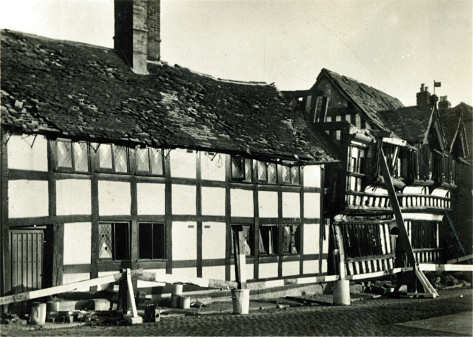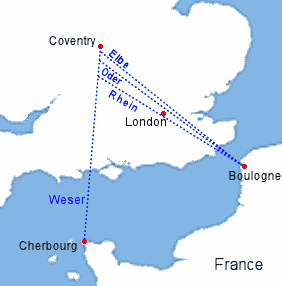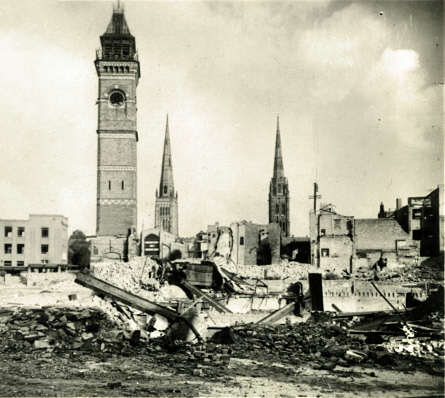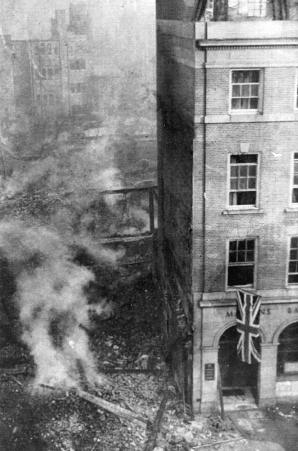|
Index...
|
 n 1940 the principal form of defence against night attacks comprised anti-aircraft guns and barrage balloons. By the 14th of November Coventry had 56 barrage balloons, which were typically deployed at various heights up to around 5,000 feet (nearly a mile). They were intended to keep the German bombers at a height at which bombing accuracy would be poor, and also to discourage dive-bombing; but some visual accounts by Coventry citizens suggest that this was not wholly effective.
n 1940 the principal form of defence against night attacks comprised anti-aircraft guns and barrage balloons. By the 14th of November Coventry had 56 barrage balloons, which were typically deployed at various heights up to around 5,000 feet (nearly a mile). They were intended to keep the German bombers at a height at which bombing accuracy would be poor, and also to discourage dive-bombing; but some visual accounts by Coventry citizens suggest that this was not wholly effective.
Although attempts to intercept bombers in the air were made, the rapidly developing technology of the time, airborne RADAR, was still very much in its infancy and would not be fitted to our night fighter aircraft until the following month. Pilots using purely visual detection had very little success engaging and shooting down enemy planes, and this attracted unfair criticism of the R.A.F. at the time, with many of the public wondering why our pilots were so innefective. To better explain this, I will include a paragraph from Enemy Coast Ahead by the celebrated Guy Gibson V.C. (leader of the famous 'Dambuster' raid in May 1943), who himself flew over Coventry on one of the nights we were bombed, with every intention of shooting down Luftwaffe bombers:

The network of anti-aircraft guns in action around Coventry on the night of the Blitz consisted of 24 heavy guns (3.7 inch) and 12 lighter, quicker firing guns (40mm Bofors.)
The constant thudding of these guns provided a great morale boost for the people, giving the impression that we were "giving it" to the enemy. However, despite this perceived success, the guns in reality were quite ineffective. This had indeed been predicted before the outbreak of war when air defences were being discussed, and previous 'ack-ack' exercises had yielded poor results.
Another method the British could use to foil attackers was to interfere with their Radio guidance system. The first wave of bombers sent by the Germans was Kampfgruppe 100, (known as pathfinders) whose job was to accurately locate the target and drop incendiaries, which would then mark the area for succeeding waves of bombers to easily follow.
To enable the pathfinders to find a target in the dark, the Germans had tried several methods; the most common system in the period leading up to the November Blitz being a pair of intersecting beams known as Knickebein (meaning 'crooked leg'). In November, however, the Germans employed a new system known as X-Gerat (simply meaning 'X Apparatus'), consisting of four radio beams. (See map below showing how Coventry was targeted.) Each beam was named after a German river, and the planes would initially follow roughly along the path of 'Weser', transmitted from Cherbourg.

When they eventually crossed 'Rhein' the planes would follow the course more precisely, then another 30 kilometres further on, the next beam, 'Oder', would tell them to start their bomb-release clock mechanism. Finally, crossing 'Elbe' would start a 50 second timer, ready to release the bombs.
These German direction finding systems were unsurprisingly known by us as 'headaches'. Our counter-measure for this method was appropriately nicknamed 'aspirin', and our idea was to send out our own radio beams in a slightly different direction, in order to try and send the German pilots off course (a method commonly referred to as 'bending the beams'). The X-Gerat radio signals were highly directional VHF 'carrier waves' modulated with an audio signal, which could be heard in the pilot's earphones to let him know that he was crossing a particular 'beam'. However, these radio signals were usually switched on by the Germans a few hours before an air-raid, (although not initially in the eventually intended direction) and this enabled British planes fitted with suitable radio equipment to fly across the beams and attempt to measure which frequencies were being transmitted by the German radio equipment. The Avro Anson was commonly used to carry out these detection missions.
The measuring equipment used back then had very limited accuracy, but on the afternoon before the big raid of November 14th, Doctor (later Professor) R. V. Jones, the technical wizard working for British Intelligence, used immense skill, and, as he later admitted, some good fortune, to work out the carrier frequency being used. Another radio engineer, possibly at Farnborough, worked out that the modulated 'audio' signal was at 1.5kHz. At that point, nobody here knew what the intended target was, but at least we knew on which frequencies to set our jamming equipment....

....or at least, we thought we did! R. V. Jones knew that the net result of any miscalculation on our part would undoubtedly be hundreds of casualties. To his great horror, the audible signal that was intended to be followed by the German pilots was either measured or heard incorrectly by somebody here. As stated, we had set the audio tone on our jamming signal to 1.5kHz (1,500 cycles per second) - but the Germans were listening out for a tone of 2kHz from their radio beams. In fact, had their pilots actually been listening 'audibly' for that tone, then our counter-measure might have had a slim chance of success. However, the study of a captured Heinkel carrying an X-Gerat radio receiver later revealed that their equipment automatically filtered out everything either side of 2kHz, and so the German pilots were oblivious to our "British tricks" and kept on course.... on this occasion for Coventry.
Three days earlier the British first learned that a big raid was planned. On the 11th November intelligence was gathered from two sources; a German prisoner of war talking to a room mate (either someone 'planted' or he might've been bugged) about a raid on a larger scale than ever previously attempted - and from German signals decoded by the captured Enigma machine. (Intelligence gathered in this way was known as ULTRA.)

The code-breaking staff at Bletchley Park, Buckinghamshire, had deciphered material that suggested a German operation by the code-name 'Moonlight Sonata', and this would most likely take place during the period of full moon, around the 14th/15th November. Also, teasingly, the Germans had sent codes for three possible places as the bombing target - but only two of them had been deciphered by the time the raid came.... Wolverhampton and Birmingham.
Target 51: Wolverhampton had been worked out from the decoded message "Einheits Preis", which translated as "single price". The slogan for the Wolverhampton based Woolworths store was "Nothing over sixpence", and our scientists soon saw the association.
Target 52: Birmingham was the home of former Prime Minister, Neville Chamberlain, and the decoded signal of "Regenschirm", meaning "umbrella" (an item famously carried by Chamberlain) gave away the second possible target.
However, the clues for the third target eluded our intelligence staff, and although the word "Korn" kept cropping up in various decrypted signals, its meaning was not obvious, and unfortunately, it was not until the afternoon of the 15th that scientists finally realised that the Germans had, in this case, not used any clever cryptic clues, but simple alliteration.... Korn was Coventry - Target 53. By then, of course, it was too late!
The quick answer to this is "yes". As explained above, despite there being no definite target gleaned from our Top Secret ULTRA intelligence, the R.A.F. were able to detect the direction of the German radio beams shortly before an intended raid. On the afternoon of the 14th November, around 3pm, the enemy's directional radio signals appeared to be aligned over Coventry. Although this was not made public, a fascinating piece of information has been passed to me by Tony Clarke, whose father, PC Reginald Clarke, reported that Coventry's emergency services were "placed on alert at 5pm and warned to expect a heavy air raid". This report was confirmed by several of Reg's colleagues. Tony also adds; "Many of his colleagues also confirmed that there had been messages calling off-duty officers into the St. Mary Street Police Station for briefing and allocation of duties".
As is well known though, the public were not given this same warning. With hindsight this was probably a wise decision, as an alert of that nature would almost certainly have caused widespread panic, blocking the streets to emergency vehicles and hindering the jobs of ARP wardens and firefighters. At that early stage it could not have been known just how heavy or prolonged the raid was to become, and even if it had been predicted, two hours would not have been enough time to evacuate a city of 200,000 citizens.
See Did Churchill leave us to be bombed? on my "Conspiracies and Myths" page.
This is your first visit to my website today, thank you!
3,150,256Website by Rob Orland © 2002 to 2024